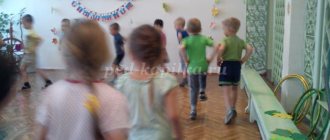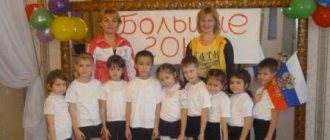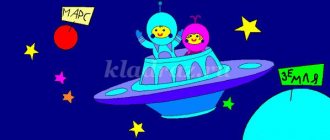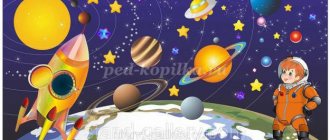"Cosmonaut School" Sports entertainment for children of senior preschool age
Program content:
- Expand children's understanding of space, Cosmonautics Day;
- Develop healthy lifestyle skills;
- Develop physical qualities of the individual - speed, agility, endurance, mobility;
- Contribute to the unity of the children's team, create a situation of emotional well-being in the form of play activities.
Progress of entertainment
Instructor: Hello, guys! Do you know what day it is today? Today the whole country celebrates Cosmonautics Day!
Instructor: What happened on this day? (Children's answers)
Instructor: The fact is that it was on April 12, 1961 that our cosmonaut made the world's first space flight. Do you know who was the first person to go into space?
(Children's answers. Yuri Alekseevich Gagarin. He flew around the globe on the Vostok spacecraft.)
Instructor: How do you understand what space is? (Children's answers)
Instructor: There are many galaxies in outer space. And our solar system is located in one of these. And our planet is the third in a row. And how many planets in the solar system we learn from the poem.
Child:
In order, all the planets can be named by any of us: One - Mercury, Two - Venus, Three - Earth, Four - Mars. Five is Jupiter, Six is Saturn, Seven is Uranus, followed by Neptune. He is the eighth in a row. And behind it, then, is the ninth planet called Pluto.
(Author of the poem - A. Khait)
Instructor: Well done, you really know all the planets, but would you like to become an astronaut and see other planets?
Well, then I invite you to the astronaut school; where today two space squads will be tested and compete in strength, agility, speed, and courage. (Command View)
Meet the space squad "Comet". Motto: Comet has a motto - never fall down!
Space squad "Sputnik". Motto: In order to fly into space and to the stars, we are ready to show ourselves now!
Instructor: A jury will evaluate today's tests at the cosmonaut school. (Jury Presentation)
Are the teams ready for the challenge? We will start our competition with a warm-up.
1. Warm up
Teams line up in two lines, break up, and perform general developmental exercises as shown by the instructor, accompanied by musical accompaniment (music from the movie “Great Space Journey”).
2. Space Rocket Relay Race
At the starting line, each team has 8 gymnastic sticks and 2 hoops. Team members take turns taking one item and placing a rocket on the finish line.
Instructor: You have made wonderful rockets, now you can launch into space.
3. Relay race “Running into a rocket”
Children, on command, taking turns overcoming obstacles (walking along a rope while maintaining balance; then jumping through 4 hoops), must quickly take a place in the “rocket”. The whole team must be in the “rocket”.
4. Relay race “Loading the rocket”
Instructor: Do you know that a flight in space can last a very long time, so astronauts need a lot of food, supplies of water and oxygen, and equipment. The next competition is called “Loading the Rocket”. You need to go through obstacles (walk along a ribbed board; go around cubes arranged in a checkerboard pattern; crawl under an arc) and deliver the load (balls) to the rocket.
5. Competition “Conquer weightlessness”
Instructor: In outer space, gravity does not act, all objects, even the heaviest, become light as a balloon, in space there is weightlessness. And in the next test, our teams will try to cope with weightlessness (each participant must use a stick to push a balloon into a bucket).
6. Competition "Intellectual"
Instructor: It's time to show the teams your knowledge about space. The next competition is intellectual (teams solve riddles).
Chain of riddles for children:
1. To equip the eye and make friends with the stars, To see the Milky Way, so gentle and powerful... (telescope)
2. The life of planets has been studied using telescopes for hundreds of years. A smart uncle will tell you about everything... (astronomer)
1. Astronomer - he is an astronomer, he knows everything inside out! Only the full sky is visible better than the stars... (moon)
2. A bird cannot fly to the moon and land on the moon, but a fast one can do it... (rocket)
1. The rocket has a driver, a lover of zero gravity. In English: “astronaut”, and in Russian...(cosmonaut)
2. An astronaut sits in a rocket, cursing everything in the world - As luck would have it,... appeared in orbit (UFO)
1. A UFO flies to its neighbor from the constellation Andromeda, In it, an angry green one howls like a wolf out of boredom... (humanoid)
2. The humanoid lost its course, got lost in three planets, If there is no star map, the speed... (of light) will not help.
1. Light flies the fastest, it doesn’t count kilometers. The Sun gives life to the planets, gives us warmth, tails -... (to comets)
2. The comet flew around everything and examined everything in the sky. He sees that in space a hole is a black... (hole)
1. In black holes, the darkness is occupied by something black. The interplanetary spaceship ended its flight there... (starship)
2. The starship is a steel bird, it rushes faster than light. Learns in practice the stellar... (galaxies)
For both teams: And the galaxies fly in all directions as they please. This whole…(universe) is very healthy
7. Competition “Collect a constellation”
Teams must make the Ursa Major constellation out of paper stars. Each participant, in turn, riding on a large ball - a fitball, brings his star to the star map and places it in the right place.
8. Obstacle course “On the Moon”
Instructor: Our teams face the last test. We are landing on the surface of the Earth's satellite - the Moon. There are many obstacles on the lunar surface: craters, mountains, depressions. Let's see how the teams will overcome all the obstacles (crawl along a gymnastic bench on their stomachs, pulling themselves up with their arms; walk a distance, placing foam rubber circles in front of them; hit a hoop with a bag of sand; run back back).
9. Competition “Portrait of an Alien”
On a sheet of paper mounted on an easel, each blindfolded participant must draw one of the alien's body parts (head, eyes, mouth, nose, ears, torso, tentacle arms, legs).
Instructor: The aliens turned out to be wonderful, funny with kind faces (children dressed as aliens enter). And here they themselves came to us from a distant galaxy. And they want to please us all with a real space dance (children perform a dance to the music of the group “Space”).
Instructor: Our competition at the cosmonaut school has come to an end. The jury gives the floor.
The jury sums up the results of the competition.
Members of both teams are awarded certificates stating that they have completed training at the cosmonaut school, and they are awarded the honorary title “Young Cosmonaut”. Teams are awarded certificates.
Author: Pavlova Larisa Vyacheslavovna, physical education instructor at MDOU kindergarten No. 5 in Valuyki, Belgorod region.
The article is published in the author's edition.
Outdoor games for Cosmonautics Day
Outdoor games for Cosmonautics Day
"A space "
-
an outdoor
game for children 4 - 7 years old.
Description: All children can play this game, both indoors and outdoors. All the children scatter. The hands are raised up, connecting the fingers in the center, as if depicting a rocket. Educator: - Rockets, get ready. The children sat down. The teacher suggests saying the countdown together. All: - Five, four, three, two, one, let's go! Children fly without bumping into each other. Educator: - We've arrived. The children sat down.
"Martians"
- low
mobility game for children 4 - 7 years old
.
Description: All children can play this game, both indoors and outdoors. All children stand in a circle. With the help of a counter, the leader is selected. He gives cards
, face down.
They depict either people or “little green men” (Martians)
. The presenter closes his eyes and says the words:
Arrived _
I'm on the planet
Could this be a wonder of the world?
Well, maybe somewhere nearby?
It’s important for me to know everything in the world,
And unravel your secret.
At this time, children should look at the images of their cards.
. Their task is to show the presenter who they are - people or Martians, without uttering a word. The host comes up, clicks on the player and guesses. Then the host becomes the one who portrayed his role most interestingly.
«Astronauts»
-
an outdoor
game for children 4 - 7 years old.
Description: Children can play this game, dividing into subgroups, both indoors and outdoors. We lay out hoops throughout the playing space - these are “space suits”
.
There should be one less than participants. Cosmic music
plays , children run everywhere without stepping on hoops. The presenter says the words:
Friend, don’t yawn, but put on your spacesuit!
Players must stand in the hoop as quickly as possible and lift it up (as if putting on their spacesuit)
.
Anyone who did not have time to put on a spacesuit sits on a bench (remains on the ground)
.
The game continues, again with one less hoop. So, until there is only one winner left. This is who will be the first to fly into space
. The rest are not upset, next time they will definitely win too.
Flight
Participants are given the most ordinary plastic bags. They should be small in size and not too dense. At the leader's command, each participant tries to keep his bag in the air. To do this, he blows on it from bottom to top. The winner is the one who can carry out the longest flight of the package over the ground.
Gagarin
Participants of the competition stand in a circle and join hands, forming an orbit. In the center of the circle there is one - “Gagarin”. From time to time, players raise and lower their hands. The task of “Gagarin” is to break out of the circle within one minute, that is, “fly out of orbit.” The presenter records the time and monitors compliance with the rules of the competition.
Rocket
Competition for a young company. Participants are divided into teams. In each of them, a player is chosen to play the role of a “rocket”. The rest form two rows. Participants standing in opposite rows opposite each other join hands, forming a kind of “rocket” bed. The task of each team is to deliver its “rocket” to the finish line faster than the other.
Astrologer
Participants are located around the playing area in random order and crouch. They depict “stars,” but the “star” can only shine in a “standing” position. It is at this moment that the “stargazer” (driver), walking between the “stars,” must touch the player. If he managed to do this before the participant sat down again, then the “star” becomes a “stargazer”.
Bright constellations
For this competition you will need a constellation map (you can download it from the Internet and print it). Guests are divided into teams. The presenter shows by this constellation, for example, Orion, Ursa Major, Canis Major, Aquarius, and so on, and the teams answer in turn. The correct answer is one point per score, the wrong answer is zero. At the end of the game, each team's scores are tallied and the winner is determined.
Expedition to Mars
The presenter prepares in advance a long list of items that, in his opinion, must be taken with you on an expedition to Mars. He quickly reads it out loud to the players once, and then asks them to stand in a circle and take turns naming one item from the list. The one who names something that was not on the list, or repeats it, “flies to Earth” - sits on the floor. The one who remembers the most items from the list wins.
He is an astronaut and an astronaut in Africa
For this competition you will need helmets (boxing helmets, motorcycle helmets, racing helmets, whatever you can get), in extreme cases, the helmet can be replaced by wrapping several scarves around the participant’s head to make it look like a helmet. At the command “5, 4, 3, 2, 1, let’s go!” each participant begins to assemble a simple and small mosaic. Whoever is the first to correctly assemble the puzzle will receive the title of a real astronaut.
Baikonur
Each participant receives a sheet of paper and rolls a tube out of it, that is, creates his own rocket. Then they all stand along the same line and “launch” - they try to throw the tube rocket onto a cabinet or shelf. In this case, you cannot raise your hand above waist level. Those who succeed move on to the next round and receive a piece of paper half as large. The game continues until one winner is determined.
Training to become an astronaut
Participants are divided into pairs and show their astronaut training. The couple needs to pump up the press in half 100 times, that is, first one participant holds the legs of the other, and he pumps, and then vice versa. The pair that completes the task faster is ready to fly.
Games at home for children and more...
These games about space for schoolchildren will be very useful for Cosmonautics Day. Play with pleasure and joy!






